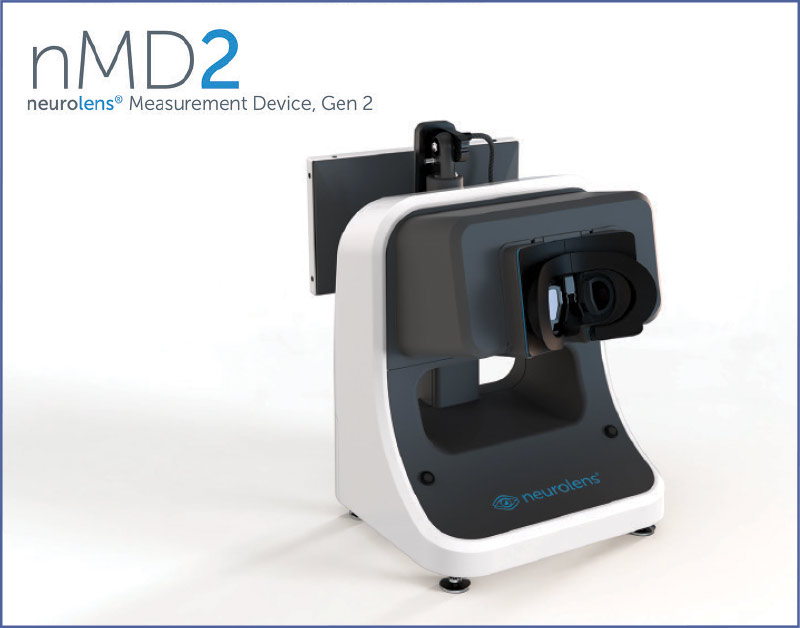
Sponsored by Neurolens
By Lori Passarelli, ABOM-AC
When educating a patient about Neurolens, everyone in the practice is involved in the Neurolens process, from the technician to the doctor to the optician. Therefore, it is imperative that all staff are knowledgeable on eye misalignment and trigeminal dysphoria, and how Neurolenses are proven to help alleviate symptoms in the vast majority of wearers. Staff knowledge creates confidence when educating the patient about Neurolens; this, in turn, confers confidence in the patient.
Engaging staff members through hands-on training and educational videos provided by Neurolens elicits enthusiasm. Team effort makes the flow seamless for the patient. Testing each staff member on the NMD2 will give them a better understanding of the patient-facing experience and help identify staff members who make good Neurolens candidates, giving these staff members the opportunity to tell patients about their own personal experiences with the product. Enthusiasm is infectious, and there’s nothing like testimony from a staff member who wears Neurolens and is reaping its benefits. Knowing keywords and having a solid understanding of the NMD2 and Neurolenses will facilitate authentic messaging when speaking to the patient. Roundtable discussions following the training opens the opportunity to clarify questions and hear how others might explain the process, symptoms and benefits of Neurolenses to the patient.
The Neurolens process is straightforward. After determining a patient’s symptomology through a short questionnaire—available in both digital and print form—the technician/optician sets up the patient at the NMD2 and prepares them for the test, which takes less than two minutes. The first thing the patient sees is the word Neurolens. Next, the patient is shown an underwater scene, where a submarine with a yellow propeller appears. The technician instructs the patient to focus on the yellow propeller as the submarine moves into the distance while the machine measures the distance PD to a 10th of a millimeter. Next, fish appear to be swimming all around while the patient focuses into the distance (farther than 6 m). Next, six circles appear, and the machine measures distance base alignment or dissociated phorias. Each eye sees something different, but the brain combines them into one picture. The device measures how much eye movement is present. Even though the target is stationary, the patient perceives it as moving from side to side. The device then presents fish swimming all around to both the eyes while the yellow propeller is being flashed to one of the eyes. The machine measures distance fixation disparity or fine alignment during this presentation. The process is then repeated at near (50 cm). The machine measures near PD, near base and fine alignment. The device then provides a prescriptive recommendation that the doctor can readily use. All this happens in less than two minutes, which is far less than traditional diagnostic methods.
Next, the patient is taken to the exam room, where they discuss their results with their doctor. Patients trust their doctor; therefore, their recommendation strongly impacts patient confidence and likelihood to purchase. Viewing a simplified summary of the NMD2 measurement results with the patient makes it easy to explain their misalignment and affords the doctor an opportunity to explain in simple terms how Neurolenses correct this misalignment. Examples of clear statements that make it easy for the patient to correlate symptom relief with Neurolenses might be along the lines of, “Neurolens allows your eyes to work together as they’re supposed to, without straining. Relieving eyestrain may reduce or alleviate symptoms such as neck strain, headaches or even motion sickness.” Patient-friendly brochures about Neurolens are always helpful, as is directing patients to explanatory videos available on the Neurolens website or YouTube channel.
Next is the all-important doctor-to-optician handoff. Mentioning the prescription for Neurolenses and the patient symptoms being addressed during this handoff process allows the optician to echo keywords used by the doctor when guiding the patient through the dispensing process. Many opticians find it compelling to explain the cost/benefits of Neurolens by comparing it to the cost incurred for other treatments in attempts to relieve the symptoms of trigeminal dysphoria such as chiropractor, massage/physical therapy, doctor visits and medications.
Glasses that are aligned and fit properly make a difference in how well the patient sees, especially with prism lenses. The patient may need time to adjust and feel comfortable, as with any glasses. Many people adapt rapidly while other others may need more time to feel comfortable and managing expectations during the dispensing process is important to maximizing outcomes for all patient types. Patient testimonials abound that indicate any adaptation period is worth the relief experienced. Patients become very emotional when sharing how life changing Neurolens has been for them with many having suffered for years without effective treatment.
With many positive patient and doctor testimonials available, optometrists can feel confident prescribing Neurolenses. And opticians can be comfortable dispensing Neurolenses as well. As Ray Corbin-Simon, OD, of Piscataway, N.J., says, “It’s been amazing. The pain that I used to feel in my neck has dissipated, and I can comfortably sit and read with my eyeglasses, which I couldn’t do before; I haven’t seen a chiropractor since then. I’m a true example that this does work.”













